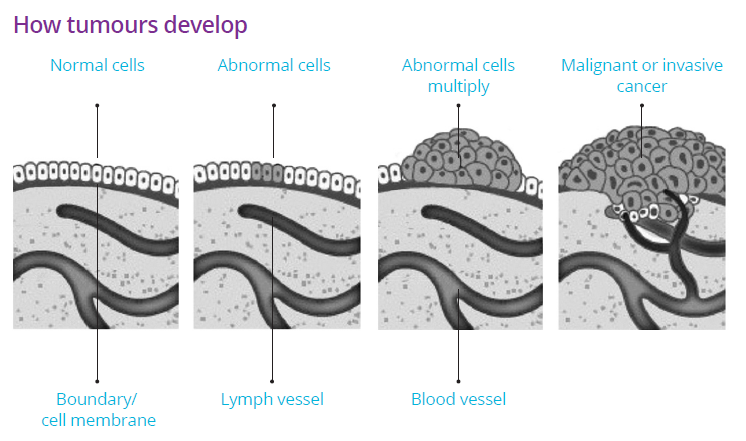Subscribe to our email newsletter
Be kept in the loop about our latest news on pancreatic cancer, the charity and our supporters.
Firstly, what is cancer? All cancers begin with changes in a cell or group of cells. Cells are the basic building blocks of all living things. The body is made up of many types of cells, which usually grow and divide in a controlled way to make more cells. These new cells are needed to keep the body healthy.
When cells become old or damaged, they die and are replaced with new cells. The way a cell grows, divides and dies is controlled by its genes (a short section of DNA). Sometimes DNA gets damaged or changed. If this damage affects genes that tell a cell when to grow, divide or die, cells do not die when they should, and new cells form when the body does not need them.
The extra cells which are made, change the composition of the blood, or forms a lump, called a tumour, which is the beginning of cancer.

| Benign tumours aren’t cancerous. They can often be removed and, in most cases, do not come back. Cells in benign tumours do not spread to other parts of the body. |
| Malignant tumours are cancerous. Cells in these tumours can invade nearby tissues and spread to other parts of the body. Sometimes cells move away from the original (primary) cancer site and spread to other organs and bones where they can continue to grow and form another (secondary) tumour at a new site.
This process is called metastasis. Secondary cancers keep the name of the original cancer location. For example, pancreatic cancer that has spread to the liver is still called pancreatic cancer. |
 The information provided in this site, or through links to other websites, is not a substitute for medical or professional care and should not be relied upon as such. Read our disclaimer.
The information provided in this site, or through links to other websites, is not a substitute for medical or professional care and should not be relied upon as such. Read our disclaimer.
Sources and references for this information product will be supplied on request. Please contact us quoting the Information Product number below:
| Information Product № | PCA0011v1 | Published | 26/09/2022 |
|---|---|---|---|
| Last Updated | 26/09/2022 | Next Review Due | 01/09/2022 |